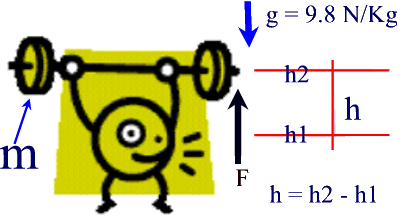Work Done When Lifting Objects

Recall that the force of gravity Fg = m x g
Therefore, the work done in lifting an object against gravity can be calculated using the equation
W = m x g x h
Example
What is the work done by an elevator on 5 people (800 Kg) inside the elevator, if they all get off on the 4th. floor (12 m above the ground)?
Solution:
Given:
m = 800 Kg, g = 9.8 N/Kg, h = 12 m
Find: W
W = m x g x h
= 800 Kg x 9.8 N/Kg x 12 m
= 94080 Nm
= 94 080 J
Therefore, the work done in lifting an object against gravity can be calculated using the equation W = m x g x h
Example 2:
What is the work done by an elevator on 5 people (800 Kg) inside the elevator, if they all get off on the 4th. floor (12 m above the ground)?
Solution:
Given:
m = 800 Kg, g = 9.8 N/Kg, h = 12 m
Find: W
W = m x g x h
= 800 Kg x 9.8 N/Kg x 12 m
= 94080 Nm
= 94 080 J


